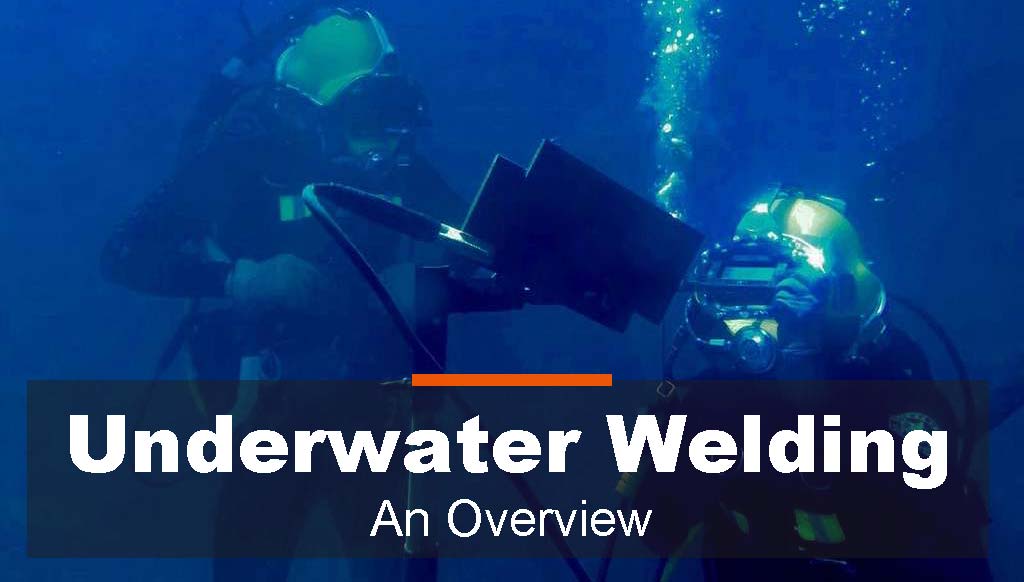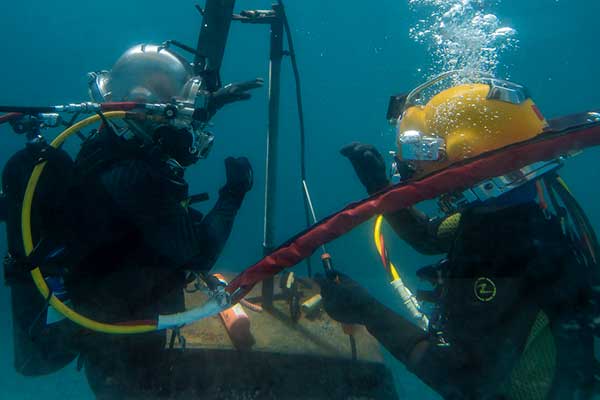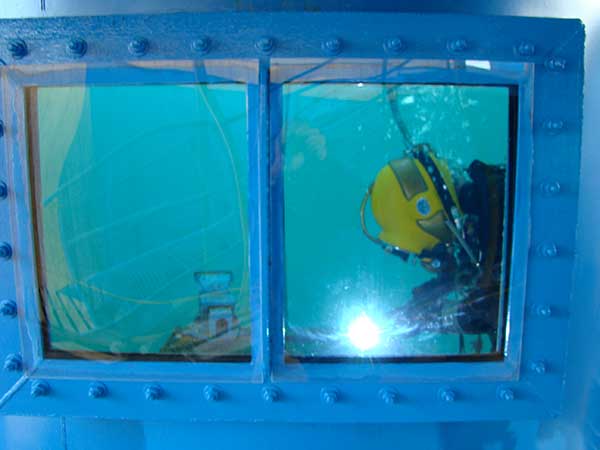
Underwater Welding – A Dangerous Profession
Underwater welding Technology is accomplished while the welder or diver is submerged, generally at a raised barometric pressure. This process initiates a series of challenges that require specialized training and skills that can only be acquired at any commercial diving academy. The adverse conditions and inherent risks associated with underwater welding make the diver/welder gain expertise of rigorous standard.
It is one of the most well known and lucrative jobs available to trained commercial divers. Most people have a basic concept of welding, but how exactly is it accomplished underwater? Here we are going to know more about an interesting yet dangerous career.
What is Underwater Welding?
Hyperbaric welding or underwater welding has been conceptualized since early1930. It is still being done in many parts of the globe for the maintenance of marine infrastructures that are partially or fully submerged in water. Generally, the inland welders work on dams, bridges, small water vessels while offshore underwater welders work on oil rigs, pipelines, large ships, underwater habitat, and nuclear power centers.

Welding underwater and on dry land is actually not different as the basic welding techniques and equipment remains the same. The underwater welder needs typically training and certification as for the surface welder. This field is in a danger zone and needs years of training to acquire knowledge and skill along with a certification from an accredited dive school.
In the case of underwater welding, the first thought that crosses any mind is the danger of mixing electricity with water. This threat is one but still not the biggest one. Despite all, still few choose this as a career choice for excitement, challenges, and a very good payout.
Underwater Welding Categories
There are two main categories of underwater welding:
1 Wet underwater welding
2. Dry underwater welding or Hyperbaric welding techniques
1. Wet Underwater Welding
Shielded metal arc welding (SMAW) is commonly employed with a waterproof electrode. The other process of welding can be used are flux-cored arc welding and friction welding. In every process welding power supply is connected to the power source through hoses and cables.
The process is confined to low carbon steels, at a greater depth, because of hydrogen caused cracking.
2. Dry Underwater Welding
The welding is performed at a pressure in a chamber filled with a mixture sealed around the structure to be welded. This process employs the Gas Tungsten Arc Welding (GTAW) power source with high integrity of welding.

The applications of this welding process are multiple, ranging from repair, construction of ships, pipelines, and offshore platforms. Here steel is the most common material to be welded.
As underwater cutting, oxygen arc cutting with exothermic electrodes & steel tubular electrodes have been used.
The danger of the job and demands of the body, welder/ cutter need to work for one month with off from the job for three months.
This overview is not a substitute for the manufacturer’s instructions and professional guidelines but general information only.
Steps of the Deep Underwater Welding Process
- Arrange a pre-job meeting for the safety analysis of this job. The crew should get together at the beginning to review the risks and hazards to plan the process.
- Straight polarity is used by employing an adequate size DC welding generator. Here negative lug connected to the torch while the positive lug to the ground leads to achieving the straight polarity. AC is prohibited for welding or burning in the water. The alternating current once produces an electric shock, it prevents the relaxation of muscles that control the hands. Here in electrocution of AC, the diver may be unable to let go if his equipment or body enters accidentally in the electrical circuit.
- Insulated gloves are mandatory at times of welding or burning.
- The ground lead of the generator should be attached as near as possible to the worksite so that the diver is not between the ground and electrode.
- It is mandatory to make a positive operating disconnect switch on the torch side. At the time of diver changing the rod or other thing than burning, the switch for disconnect be in an open position. The opening and closing of the switch should be controlled by the diver. A command from the diver should say make it hot or make it cold.
- Easy step to check the polarity is to dip the rod tip and ground clamp in a bucket of saltwater. Close the safety knife switch to energize the rod. There will be a stream of bubbles from the tip of the rod and if not then reverse the polarity and retest.
- The moment the diver enters for the process, the first task is to clean a spot for the grounding clamp. The spot needs to be positioned such as in front of the diver and closest to the weld joint and requires cleaning by scraping and wire brush to be shiny clean. The C type clamps are better in underwater welding for divers safety. The clamp must be secured firmly to the workpiece with sufficient cable from being pulled loose. The ground must be placed in a diver’s line of vision.
- The test weld is advisable to check the heat at the working depth.
- As the electrode is consumed to 3″ of the torch, stop the process and signal to ‘make it cold’ before trying to change the electrode. Maintain the torch in the same position of cutting unless acknowledged ‘make it cold’ or ‘switch off’.
- The welding torch must have a flash arrestor as a safety norm.
- Never try to speed the cutting and create a fire deep inside the metal, as in such a situation there can be a possibility of explosion.
- Never cut non-ferrous metals underwater as they do not oxidize and need to be melted. This situation may lead to an explosion.
- Underwater ignition is prohibited when oxygen pressure is low. It may burn the cable inside on its own, blowing holes in the cable that can result in injury.
- There is a possibility of electrical shock if welding/cutting is done in a partially immersed situation.
- As the acetylene is very unstable at a pressure above 15psi so is unfit for underwater cutting.
- The distance between the hand and electrode tip should be never less than 4″.
- The diving welder needs to maintain a written record of the following parameters in order to redo what worked in the next cutting or welding session
- The tong meter to read the welding amperage
- The open and closed circuit voltage noted by the reading voltmeter.
- Electric polarity.
- Length of the welding cable.
- Electrode diameter manufacturer, type, and waterproofing material.
- The depth of the work station site.
Underwater Welding and Burning Risks
To make an assurance of the integrity of underwater welding is not an easy task as the defects in welding may remain undetected. The risk of the underwater welding remains of the electric shock to the welder/diver.
To overcome these, the welding equipment ought to be insulated properly and the voltage of the power source should be controlled.
The safety concern of normal divers like decompression sickness due to the increased pressure of the inhaled breathing gases should also be considered by the underwater welder.
Gases Buildup on Burning
The gases can be trapped when the heat is created by burning. These gases which are trapped, need to be released by venting or jetting gas. The closed spaces can trap a small amount of gas & remain with the welder/diver. The gas must be vented out if it can be entrapped. The drill hole allows the venting of the trapped gases to the surface.
The surface going to be drilled may have sudden gases and need to vent, such as the case in the pipeline. The speed of the drilling tool needs to be controlled to keep a safe level of the temperature
- Make a safe habit to purge all pipes with an inert non-flammable and non-combustible gas.
- Make sure to create a survey of the worksite to identify the overhead hazards. The twisted and torn pipe should be addressed before burning is initiated.
- The risk limited to underwater welding is building up of oxygen and hydrogen pocket in the weld which can be potentially explosive. The grinder and drill can produce sufficient heat to ignite hydrocarbons to explode. Gases need to be vented properly. The solution remains to slow the speed of the drill bit to avoid generating excessive heat that requires to ignite the gases.
Wet Underwater Welding Demonstration Video
Mechanical Barriers & Mini Habitats
The mechanical barriers are called Caissons and Cofferdams and are used at a water wedge in the splash zone of the ships. These structures keep the water body away from the work area and weld area in the atmosphere. The technique has limited use as per the depth of the weld and size of the cofferdam. These mechanical barriers help to fix a ship’s hull and harbor facility.
A mini habitat is a name given to a small portable gas-filled enclosure. They are transparent plexiglass boxes that are placed over a joint by a diver. The water in virtue displaced by an inert gas.
These two methods allow for dry welds, which is better than wet weld as the cooling rate is slower.
Underwater Welding Arcs
The behavior of underwater welding is not the same as it behaves on the surface. The gas bubble is very important to the completion of the underwater weld successfully. As the arc initiates and burns the electrode, the displacement of water creates an envelope of gas bubbles. The pressure in the bubble increases to leave the arc and combine with the surrounding water. Now another bubble is formed to occupy its place.
The moment this pressure head becomes more extensive than the capillary force, the existing bubble will break down. In the situation of electrodes too far from the weld zone, the gases explode and blow to destroy the weld. The too-slow travel speed will make the bubble collapse around the weld and damage the possibility of a good and effective weld.
Careers and Jobs
Career Route
- Get a medical fitness nod from a doctor for diving. This involves a complete physical examination to rule out any disabilities and it is to be repeated annually as well. We rarely find an underwater welder over the age of 50 due to the physical demands of the job.
- Now it’s time to apply and complete a commercial diving course.
- Apply for a job in a commercial diving company with welding services.
- Apprentice diver or diver tender is the entry-level job.
- The commercial diving company will work to acquire a wet/dry underwater welding to pass the qualification test as per AWS norms.
- The time frame to promote from diver tender to a qualified underwater welder depends upon the support of the commercial diving company. The acute shortage of trained personnel will accelerate the path of career.
- Now you are a commercial diver, now it is better to move where underwater welding and training is the part.
- If you have acquired a scuba diver status, it is better to attend commercial diving school, for the training for safe commercial diving equipment.
- Many of the trained and experienced diver/welder may acquire the position of
- Engineer
- Welding instructor
- Instructor
- Welding inspector
- Consultant underwater welding
Skills Needed
There are multiple skills required to attain the status of “jack of all trades” in underwater welding. We find it rare to find all the skills in one person, they use multiple people on a job by the commercial diving firm.
These include the following:
- Diving skill
- Welding skill
- Underwater cutting skill
- Fitting and rigging skill
- Visual and nondestructive skill
- Drafting skill
- Photography and video underwater skills
Needed Certification
Any underwater welder must acquire a commercial diver certificate and have a degree and knowledge as a certified welder. The certifications include the following
- Diving certificate
- Welding certificate
- ASNT level II
- Rigger certificate
A welder diver is a certified welder who has secured a commercial diver certification, capable of performing assignments associated with welding setup preparation and have an ability to weld in accordance with AWS specification for underwater wet or dry welding and other weld activities.
Needed Skills
- A Great diving skill like diving physiology, safety, rigging, communication, and familiarity with underwater welding
- Weld station set up
- Preparation for welding skill
- Certification ability for underwater weld procedure.
Salary and Perks
The annual salary of an underwater welder is a minimum of five times than of a surface welder. The welders involved in a demanding project can ask up to ten times even. The salary and perks depend upon the experience, diving skills, and depth of the project.
Diver welders are assigned generally on a per-project basis.
Frequently Asked Questions (FAQs)
How does an underwater welder die?
The common belief is that electrocution is the far most common cause as the unpredictable path traverses by electric current and welding electrode. The electricity can fire into the surrounding water and can kill an underwater welder.
What is the average life expectancy of an underwater welder?
Different studies and reviews conclude that the average age of the underwater welder is approximately 35-40 years. It is an average but exceptions are there with training and precautions it can increase to any level.
What does an underwater welder do?
It is a very responsible job and they are supposed to repair pipelines, ships, dams, offshore oil drilling rigs, subsea habitat & nuclear power plants, its facilities, and others.
How dangerous is the underwater welding?
We find the biggest risk for underwater welding is the one attributed to commercial diving only. The welder may be exposed to hypothermia, drowning, and decompression sickness. We are not making the profession gloomy but make one aware of the preventable dangers. Taking all the precautions at every step makes the process equally safe.
Can the welding process shorten your life?
As there is the involvement of very intense heat, powerful electric current, deadly fumes, and very dazzling light, so due precautions are mandatory. The perfect training of welding and following the steps correctly with all the safety norms should not shorten the life of any welder.
Does a welder go blind?
Once the welder does not take proper precaution, may develop welder’s eye or photokeratitis due to UV radiation. It is an extremely disturbing and painful condition and may cause temporary blindness. Any extreme injury may lead to blindness as well.
Conclusion
Underwater welding can be the best career option if you love diving and interested in exploring the undersea arena. Observing all the recommended precautions can make underwater welding a very lucrative and safe job option.
Recommended steps and precautions at every step are the keys for underwater welding.
Your few words and suggestions help us to know your mind. Please put your comment and suggestions.
Related Posts
